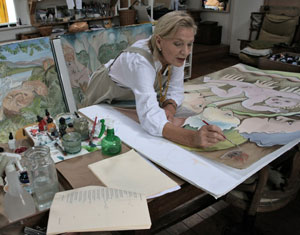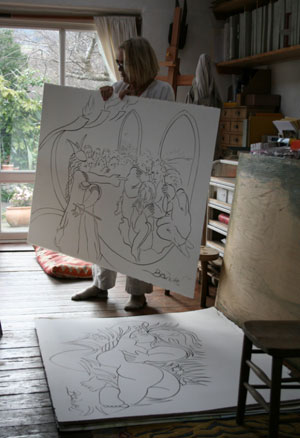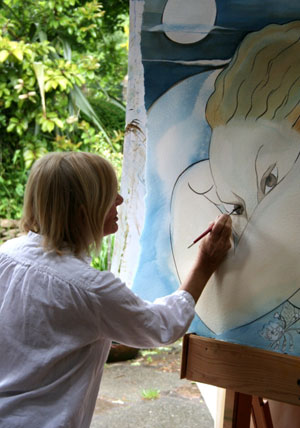Creating a Visual Translation - An Interview with Pauline Bewick
By Nina Finn-Kelcey
 Pauline Bewick was brought up on a small farm in Co. Kerry, Ireland. Her mother Harry brought her two daughters to Ireland in the late 30's leaving Northumberland, England. Harry wrote an account of their life in Kerry called "A Wild Taste" (Methuen). After Kerry, they went to live in Wales and England and travelled from progressive school to school, living in a caravan, a houseboat, a railway carriage, a workman's hut, a gate lodge and, later in a Dublin city house.
Pauline Bewick was brought up on a small farm in Co. Kerry, Ireland. Her mother Harry brought her two daughters to Ireland in the late 30's leaving Northumberland, England. Harry wrote an account of their life in Kerry called "A Wild Taste" (Methuen). After Kerry, they went to live in Wales and England and travelled from progressive school to school, living in a caravan, a houseboat, a railway carriage, a workman's hut, a gate lodge and, later in a Dublin city house.
Bewick has now been living back in Kerry for 28 years with her husband Patrick Melia. Their two daughters Poppy and Holly are also artists. Bewick works in many media in three large studios.
She started to paint at the age of two and has continued throughout her life. "Two to Fifty" was a retrospective exhibition (1,500 works) at the Guinness Hop Store in 1985, which attracted record attendances. "The Yellow Man" exhibition in 1996 at the Royal Hibernian Academy, Dublin, also drew huge numbers of all ages. The artist's biography was written by Dr. James White, art historian and former Director of the National Gallery of Ireland; "Pauline Bewick, Painting a Life". (Wolfhoud Press 1985; new edition 2001)
NFK: Once you had accepted the commission, how did you begin the creative process?
PB: Shiny, witty and so alive; this is how Kieran Byrne put the idea of a visual translation to me, saying "you of all people could do it" and I knew he was right. From the very start he trusted me. Years ago I had read the Midnight Court and the title had led me to thinking of courting at midnight! And in a way, maybe that's the idea?
 Inspiration can be so elusive, so I immediately sketched ideas into my small sketch book. I let the excited air drop into my pen and scribbled the first sketches. Yes, they had what I wanted. I then traced the best parts and took them to an architect's office in Dublin and had them enlarged on to tracing paper, size 42" x 50". Back in Kerry, I transferred them down with graphite paper onto the thick arches paper.
Inspiration can be so elusive, so I immediately sketched ideas into my small sketch book. I let the excited air drop into my pen and scribbled the first sketches. Yes, they had what I wanted. I then traced the best parts and took them to an architect's office in Dublin and had them enlarged on to tracing paper, size 42" x 50". Back in Kerry, I transferred them down with graphite paper onto the thick arches paper.
Taking a brush, I painted them in acrylic sepia, bleeding the sepia lines to create shadows, spraying water with a garden, spray bottle to bleed the sepia where I wanted it to go, tilting the paper to direct it and blotting where I wanted it to stop. All this in a sort of frenzy.
I cancelled lots of events and found it hard to sleep the nights through with the buzz of what was happening.
In order to keep continuity throughout the paintings, it was important I do them more or less all at the same time. Keeping in mind the sun rises at the start of the poem and then we go through the night of the court scene until the sun rises the next day, when the poem ends. Pat (my husband) and I read it through together about a dozen times, in order to gather who was saying what. Merriman is not straight forward. His rollicking style is deceptive. The undercurrents are numerous and professor Byrne's help with his translation was essential. I did not want to dress the people in the costumes of 1780, so I kept them timeless by drapes, leaving them nude with the exception of the court room scene.
NFK: Did you draw inspiration from the area in which the poem was set?
PB: Yes. Although the time of year when I started was not July, the month in which the poem is set, I needed to see the location. Pat and I drove to Clare and stayed in Dromoland Castle, driving on the next day to Lough Greainy. There I got the atmosphere from the lake, reeds, swans and the 'curve in the river'. I did sketches and two pastel paintings near the Merriman stone plaque at Caher. The Slieve Aughty mountains were not easy to find! We eventually drove up the hill and there they were.
We went to the small village of Feakle and had lunch at Peppers Pub. We met the owner, Gary Pepper, an inspiring man who took us to meet Brian McMahon in the post office, who in turn showed us an old photograph of the now demolished church that stood in the graveyard and was perhaps the setting of the court room. We entered the grave yard and met four people who had just buried their mother the day before. We talked together amongst the gravestones and beside the secret grave of Biddy Early, the well known witch. One of the family members, Tim Molloney, quoted couplet after couplet in Irish of the Midnight Court and answered questions on places etc.
When we got home with the information on this trip I started the process in earnest. When eight paintings were done I realised we needed ten. When ten were done Kieran Byrne felt that the collection needed one more, a raunchy one. I decided to set this scene not in a Shebeen or pub, but out on the bog road and painted a scene of rollicking and frolicking, the time of conception of the illegitimate baby born to the old stager's new wife on their wedding night.
In order to keep a balance between painting and illustration, I did not throw everything mentioned in Merriman's text, i.e. in the baby scene he mentioned sweet cakes, the old hags smoking pipes, a churn of milk, the midwife and the priest. I represented all that with a turf fire in the background. My fear all the way through these paintings was that I hoped the excitement would not go away or that another idea would take over.
When it came time to consider the framing of the paintings, I decided to ask Luc Raseen who has made frames for me before. This time I asked him for 8" wide oak. An artist called Alan Hall had done lettering for the Kerry Seven Ages Collection, so I asked him to carve the couplets for each of the 11 works around the frames in Irish, gilded.
Pat Melia, Pat Keegan, Luc Raseen, Alan Hall, Kieran Byrne and myself have produced these eleven works with a flourish, no hiccups. We all wish it well.
NFK: What did you think of the poem itself?
 PB: At first reading I resented that the women should flog the men, but on second thoughts, we do have our own way of punishing men, a more subliminal way that a man would interpret as a 'flogging'. A man being more straight forward in his thinking - a woman more subtle, so I had to remember that this poem was written by a man. I find it hard to know what Merriman really thought about women. The scene where the Sheebhean wails and cries, pleading that she is beautiful and has tried many pishogues but still can't attract a man, she reminds me a little of Molly Bloom in the last chapter of Ulysses. Like Molly Bloom, she indulges in her comeliness, but I can find no hint as to what Merriman thinks of such a woman.
PB: At first reading I resented that the women should flog the men, but on second thoughts, we do have our own way of punishing men, a more subliminal way that a man would interpret as a 'flogging'. A man being more straight forward in his thinking - a woman more subtle, so I had to remember that this poem was written by a man. I find it hard to know what Merriman really thought about women. The scene where the Sheebhean wails and cries, pleading that she is beautiful and has tried many pishogues but still can't attract a man, she reminds me a little of Molly Bloom in the last chapter of Ulysses. Like Molly Bloom, she indulges in her comeliness, but I can find no hint as to what Merriman thinks of such a woman.
He does talk of women gossiping and he talks of women throwing themselves around in ditches for any man who wants to have her. And then he talks of the Queen of Craglee, with her intelligence and dignity, who takes the side of the women. There is no sympathy from the queen towards the man who wants to 'play around'. Yet Merriman puts into the mouth of the old stager the words about illegitimate children being stronger having been conceived in passion without the chains of marriage. Personally I agree with the old stager that we should not be restrained within a marriage and he may well have a point that children born from high passion may be stronger that a 'pulp of a pup'.
Merriman talks of the vitality being bled out of Ireland at the time, a thing continued until recently, but now the bright ones stay in Ireland - hence the Celtic Tiger. In Merriman's day, the wild geese created wines and the further I have travelled the more I have come across Irish descendants. For instance on the Tahitian island of Moorea, we met a fisherman, black and fat and his name was O'Connor. In Samoa, our daughters and I were painting, when along the road walked two men in Lavalava, one a pure Polynesian and the other an Irishman talking at the top of his voice in a Cork accent. He was a schoolteacher over there. There is a human need for possessions such as a farm of land, cows to milk, barley growing and all that it represents, such as fine shoes, jewellery, fine silks and cambric aprons. Perhaps this is why the female wants to tie the knot and keep a strong man on the farm to mind her children and the land. The man escaping from these restraints in his wildest wishes would like to set his seed wherever he roams. Merriman's criticism of the church and priesthood stems from the restraint that families put on a son by entering him into the priesthood. Merriman's appreciation of nature I think is huge, unlike the opinion of other scholars of Merriman. Women as well as men can have an unrestrained, hilarious enjoyment in total sexual freedom, but it trips them up should she conceive. It is she who has to look after the baby.